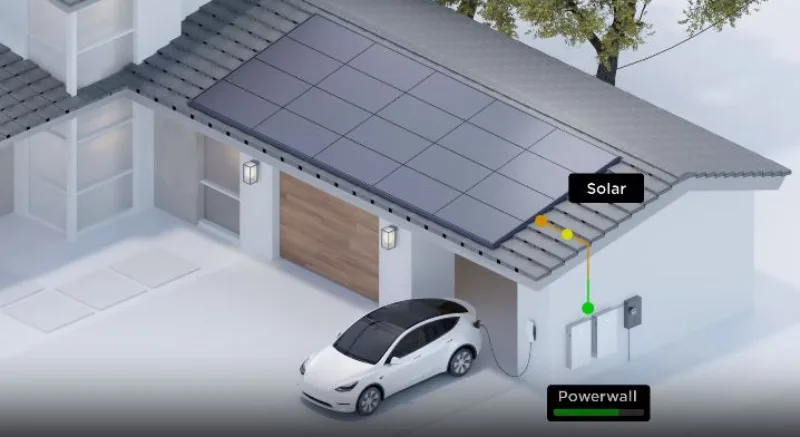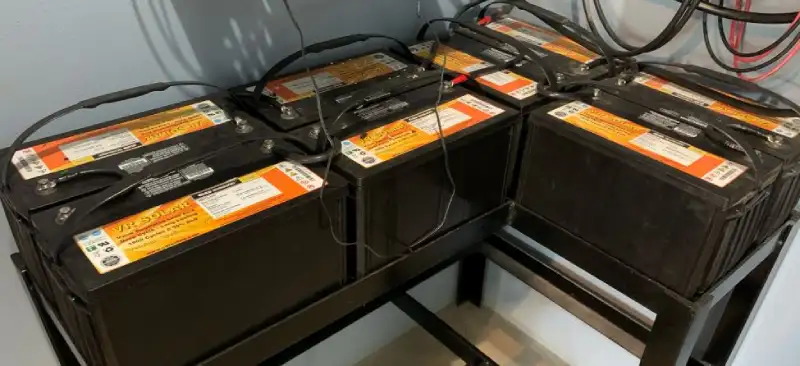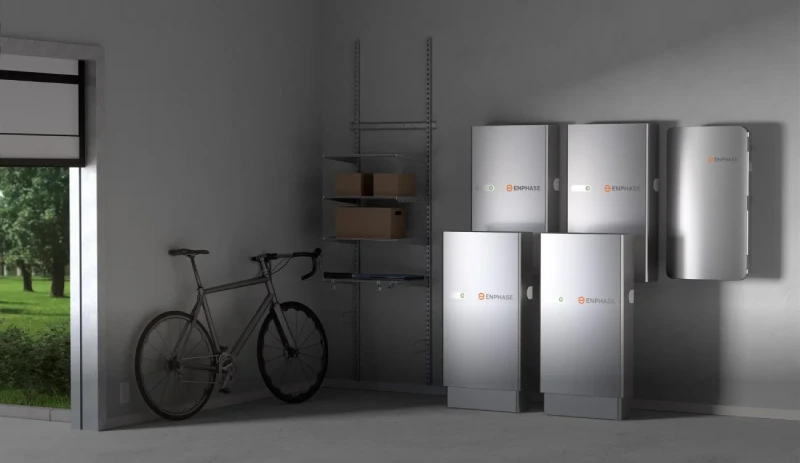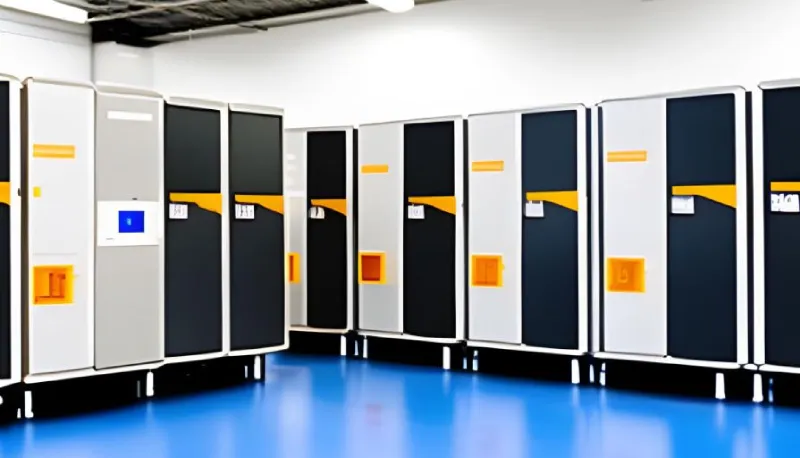A guide to PV solar batteries
The era of the distributed grid is upon us, and solar batteries are at its heart, providing storage for the increasingly ubiquitous solar panels.
These energy storage units are turning intermittent solar energy that is useless at night, into a dependable power source, comparable to a mini fossil fuel power plant but without the emissions.
At the very least, they will keep your home essentials running during a power outage, and at best, they can reduce power usage during peak hours through electricity arbitrage.
Let’s dive in!
Shortcuts
- What are PV solar batteries?
- How do PV solar batteries fit in?
- What are the different types of solar PV batteries?
- What to look for in retail solar PV batteries?
- Solar PV vs Solar Thermal batteries
- Why are solar PV batteries a game changer?
- FAQs
- References
What are PV solar batteries?
Solar batteries are solutions optimised for storing the excess electricity solar photovoltaic panels generate. Their primary purpose is to ensure a continuous power supply, reduce reliance on the grid, and decrease electricity costs by capitalising on off/on-peak electricity cycles.
In addition to being connected to solar panels, these solar battery systems are typically integrated within a building’s electrical circuit, which includes all electrical appliances, lighting, smart devices, and a connection to the national grid.
This means that the batteries often incorporate an alternator (to switch between AC and DC current), a transfer switch (to alternate between charging/discharging from the panels/grid or supplying power to the home/grid), and even support from an electrical generator.
How do PV solar batteries fit in?

Several solar battery technologies and designs integrate differently with panels, the grid, generators, and various electrical appliances, gadgets, and vehicles.
This intricate battery charge/discharge process is typically overseen by an automatic Energy Management System (EMS). This system is pre-programmed to fulfil the user’s priorities, which usually involves reducing electricity consumption from the grid (thus lowering electricity bills!) while always maintaining a reserve for emergencies.
However, the fundamental operation of batteries involves charging and discharging, which typically consists of:
- Energy Collection: During daylight hours, the battery charges directly from any surplus direct current (DC) electricity the solar panels generate. The battery might also recharge directly to the local electricity distribution network in the evenings or during overcast periods, capitalising on cheaper nighttime electricity rates.
- Energy Discharge: When the demand for electricity – from appliances, vehicles, or gadgets – exceeds the amount generated by the panels, the battery steps in to provide the necessary power. Discharging can also be prioritised during periods of costly on-peak electricity, such as early mornings and early evenings.
Most solar batteries store DC electricity, so they almost always require an alternator to convert this DC power into AC electricity, which is used by most appliances in homes, businesses, and institutions.
What are the different types of solar PV batteries?
Here is where things start getting more interesting (for some) as we can begin exploring the nuances of each battery type. The list of technologies below is chronological:
Lead Acid Batteries (Oldest tech)
Pros:
✅ Lower upfront costs (Ideal for bootstrapping)
✅ Established and recyclable technology
✅ Optimal for cold temperatures/outdoors
Cons:
❌ Heavier with lower energy density
❌ Some variants require regular maintenance
❌ Shorter life cycle (may ultimately cost more)

Lead acid batteries represent the traditional, almost archaic, form of rechargeable battery. They have been employed for decades in the automotive industry for ignition and lighting, as backup power sources for computers and data centres, in remote telecommunications equipment like cellular antennas, and recreational vehicles, boats, and various industrial electrical equipment.
Until the emergence of scalable Lithium-ion technology in the early 2010s, Lead acid batteries held the crown in the solar battery domain. Their lower initial cost, economies of scale, and accumulated expertise mean they still find use in niches where Lithium-Ion technology isn’t accessible, affordable, or suitable.
While lead-acid batteries may be on the path to obsolescence, they will retain relevance in specific sectors for some time, even though they lag behind modern Lithium-Ion systems in performance.
Three primary types of Lead Acid batteries are used for solar PV systems: Gel, AGM (Absorbent Glass Mat batteries), and Flooded batteries. The subsequent table outlines their main characteristics:
| Gel | AGM | Flooded | |
|---|---|---|---|
| Electrolyte | Silica gel suspends the electrolyte | Glass mat absorbs the electrolyte | Liquid sulfuric acid and water mixture |
| Maintenance | Maintenance-free | Maintenance-free | Requires regular water top-up |
| Positioning | Can be mounted in any orientation | Can be mounted in any orientation | Must be kept upright |
| Gassing | Minimal | Minimal | Produces gases during charging |
| Resistance to Deep Discharge | Good, but repeated deep discharges can reduce lifespan | Good resistance to deep discharge | Less resistant to repeated deep discharges (must be only partially discharged) |
| Typical Energy Capacity (kWh per unit) | 0.5 kWh - 8 kWh | 1 kWh - 3 kWh | 1 kWh - 10 kWh |
| Typical Power Capacities (Per unit, for 12 hours) | 40W - 600W | 80W - 250W | 80W - 800W |
| Typical Weight (kg per unit) | 18kg - 250kg | 20kg - 60kg | 20kg - 260kg |
| Energy Density (kWh per kg) | ~0.03 | ~0.05 | ~0.04 |
| Typical Lifespan | 2 to 7 years (depending on usage ) | 4 to 7 years (depending on usage) | 4 to 8 years (with proper maintenance) |
| Common Uses | Solar PV, UPS, marine applications | Solar PV, RVs, boats, UPS, motorcycles | Cars and trucks, solar PV, industrial backup |
Typical Lead-acid battery brands in the UK include Victron, Albion, Varta, Yuasa, Rolls.
NMC Li-Ion Batteries (Established tech)
Pros:
✅ Highest energy density (lightest and most compact)
✅ Established for over a decade
✅ Durable, rapid charging, and high-performing
Cons
❌ Prone to thermal runaway (self-ignition)
❌ Pricier than Lead Acid
❌ Contains ethically/environmentally dubious Cobalt

NMC stands for (N)ickel, (M)anganese, and (C)obalt, which define the cathode material (positive terminal) of this modern Lithium-Ion battery.
Although Li-Ion technology has been around since the 1990s, NMC batteries shook the market when they became commercially available in the early 2010s. Their superior performance made them the go-to batteries for EV charging (electric vehicles) and, shortly after, the default choice for solar batteries, as evidenced by their use in the famous Tesla Powerwall.
The leap in energy density, durability, and power capacity of NMC Lithium-Ion compared to traditional Lead-Acid batteries is significant. The technology has successfully established itself after a decade on the market.
On the downside, NMC batteries are more expensive (at least initially), contain Cobalt primarily sourced from questionable operations in the DRC (the Central African nation), and, unfortunately, they aren’t as stable as one might hope.
Prominent NMC batteries in the UK market include the Tesla Powerwall 2, LG Chem & SolarEdge.
LiFePo Li-Ion Batteries (Cutting-edge tech)
Pros
✅ Highly unlikely to self-ignite (safest option)
✅ Does not contain problematic Cobalt
✅ Consistent voltage output and longest life cycle
Cons
❌ Lower energy density compared to NMC
❌ Remains the most expensive battery tech
❌ Least established technology as it is new

LiFePO — (Li)thium, (Fe) Iron, (PO4) Phosphate– batteries are the latest generation of Li-Ion technology.
LiFePo is both chemically and thermally more stable than NMC –making it safer– while avoiding Cobalt in its construction, which has been linked to environmental issues in the DRC. Additionally, it provides a stable discharge voltage, placing minimal strain on any built-in charge stabilisers within the battery system.
However, these benefits come at a cost — both in terms of price and potentially the size and weight of the battery compared to NMC. While this might not be an issue for many households, given its only marginally lower density, it could be a concern where space and mobility are paramount.
Prominent LiFePo batteries currently available in the UK include the Enphase IQ, Duracell Energy Bank & Huawei Luna 2000.
Flow Batteries (Experimental tech)

Flow Batteries deserve a brief, honourable mention despite constraints to large-scale industrial applications. Flow battery technology possesses all the attributes needed to penetrate the residential and commercial solar battery sectors, and it’s likely to do so in the near future.
Flow batteries have the potential to become more affordable, safer, and widely available. Their advantages stem from the ubiquity of their raw materials, the simplicity of their tank and electrochemical cell systems, and the increasing safety of their chemical components over time.
- Extended Reading: The Rise of Flow Batteries: A New Era
What to look for in retail solar PV batteries?
If you’re considering installing a solar PV battery for your home or business, consider the following essential points:
Energy Capacity (in kWh)
Think of battery units as stackable, like Lego, allowing you to adjust the amount of electrical energy storage. Ask yourself:
✅ How many solar panels do you have? Aim to harness a significant proportion of its power.
✅ Do you own an EV? These demand substantial energy, often during the night.
✅ Are you engaging in complex electricity arbitrage? Greater capacity can help reduce your electricity bills.
Power Rating (in kW)
Different battery technologies offer varying power outputs (the amount of energy deliverable simultaneously). Consider:
✅ Do you use an A/C unit? They demand considerable power upon startup.
✅ What electrical heating appliances (e.g., stoves, washing machines, hairdryers) do you utilise? These are power-intensive.
✅ Do you operate an electrical pump (e.g., well pumps, swimming pool pumps)? They consume significant power.
New Fit or Retrofit (AC/DC Coupling)
New solar panel and battery installations can be optimally set up, allowing the solar panel’s DC electricity to feed directly into the DC battery without needing an alternator. However, retrofitting into an existing solar PV system (without batteries) necessitates an additional alternator between the battery (DC) and your building’s circuits (AC).
✅ Which brand of solar panels do you own? AC-coupled brands are more retrofit-friendly.
✅ Which brand of solar PV batteries are you considering? Some models are specifically designed for retrofitting.
✅ Is it a brand-new installation? Brands like Enphase are tailored for new setups.
Installer and manufacturer reputation
The combined installation of solar panels and battery systems is novel, and expertise is still catching up with demand. With emerging technologies and new engineers entering the field, the reputation of installers and manufacturers is crucial for a successful system.
✅ Does the installer have a TrustPilot review? This can offer insights into their expertise.
✅ Are you a DIY enthusiast? Many tech-savvy property owners opt to install systems themselves.
✅ Do you know anyone with a system installation? Seek their advice and choose a vetted installer and manufacturer.
Other
Evidently, there is a lot of customisability when it comes to integrated “solar systems”, so there is much more to consider. Here’s a brief summary of other vital aspects:
- Depth of Discharge (DoD): Not all stored energy in a battery is usable. Some batteries, like Lead-Acid types, can be damaged if discharged beyond their limit.
- Scalability: Sometimes, opting for a battery system that’s expandable over time is prudent. Future considerations might include purchasing an EV or providing grid support services.
- Battery Life & Warranty: Some manufacturers guarantee performance over specific years or cycles.
- Operating Temperature Range: If you’re storing batteries in a non-insulated shed in the Scottish Highlands, consider the battery type.
- Price and Incentives: It’s wise to obtain multiple quotes from solar installers.
Solar PV vs Solar Thermal batteries
The term “solar battery” can be misleading, as there are two very distinct types of solar energy storage systems:
1. Solar PV battery (Electricity Storage)
- Stores electricity generated by Photovoltaic panels (the black-coloured panels commonly seen on building roofs).
- Examples include Lead-acid batteries, Lithium-ion batteries and flow batteries.
2. Solar Thermal Battery (Heat Storage)
- Retains heat directly captured from the Sun by Solar thermal collectors (there are various types, including the solar water heating ‘Solaris Prism’ device pictured above).
- They are also known as solar thermal energy storage systems.
- Examples include – Thermal collector tanks (residential use in sunny locations) and Sand batteries (still experimental).
Each system is designed for a specific function and is kept distinct to avoid multiple energy-type conversions. For instance, generating electricity using solar PV, storing it in a chemical battery, and then using it to power an electric boiler is markedly less efficient than harnessing the Sun’s direct heat to warm water.
Why are solar PV batteries a game changer?
Let’s wrap up this guide by explaining why introducing solar PV batteries is pivotal. The reality is that solar panels, on their own, don’t offer a comprehensive solution.
Solar panels provide an intermittent energy source, meaning they can’t consistently supply the required power. Their efficiency hinges on the amount of solar radiation they receive, which fluctuates based on the time of day, season, weather conditions, temperature, panel age, etc.
This is OK if your property has a business energy connection and you aim to counterbalance some of your energy expenses without a complex system involving multiple inverters, EMS and a battery.
However, pairing the PV panels with batteries transforms them into bespoke power stations, marking a paradigm shift.
In essence, this combination enables:
- Off-grid businesses can store excess solar power harnessed in the daytime for use at night.
- Electricity arbitrage by using variable tariffs and grid flexibility schemes to make money out of your integrated solar PV system.
- Portable Solar power, by keeping your solar PV battery system permanently and partially charged.
- Carbon footprint reduction guarantees that all or most of your electricity is produced by renewable energy.
- Energy Crisis protection by becoming fully or partially independent from rising energy costs (e.g. 2022 energy crisis).
- Maximum demand meter charge reduction by avoiding on-peak business electricity prices.
- Reduced dependence on your business energy supplier.
So whether your business already has commercial solar panels installed or you’re still relying on traditional grid energy, know there is an alternative!
FAQs
We cannot cover everything we’d like without writing an encyclopedia, so we reserve this section for frequently asked questions about solar PV batteries!
What is the largest solar PV battery?
Florida’s Manatee Energy Storage Center is the world’s largest integrated solar PV battery. It boasts an energy capacity of 900MWh (comparable to 100 million iPhone batteries) and a power capacity of 409 MW (akin to a standard grid-scale gas power station), which it can sustain for two hours when fully charged.
It was completed in 2021 and is owned and managed by the Florida Power and Light Company (FPL), which also owns the 75 MW solar PV plant designated to charge continuously.
The centre comprises 132 shipping containers, housing 53,144 battery modules, spread over an area equivalent to three football pitches (approximately 15 hectares).
What other types of energy storage systems are available?
Several other energy storage technologies exist, but most are only suitable for large-scale applications. Here is a non-exhaustive list:
- Pumped-Storage Hydro: Stores electricity as gravitational potential energy in water reservoirs.
- Flywheels: Stores electricity as rotational potential energy in highly efficient, spinning masses.
- Green Hydrogen Storage: Stores electricity from hydrogen molecules produced by renewables.
- Compressed Air: Stores electricity as pressurised air within a container.
For a deeper dive: A comprehensive guide to energy storage
What size is a PV solar battery?
A standard retail solar PV battery unit is generally smaller than a conventional airline suitcase. These batteries are designed to be modular, allowing them to be stacked together to enhance their energy and power capacity.
For instance, the world’s largest PV solar battery system comprises stacks of “standard” batteries in shipping containers.
Below are the dimensions of a few popular solar batteries:
| Battery | Type | Dimensions (mm) | Weight (kg) | Energy Capacity (kWh) |
|---|---|---|---|---|
| Enphase Q10 | LFP Li-Ion | 1070 x 664 x 319 | 154 kg | 10.5 kWh |
| Tesla Powerwall | NMC Li-Ion | 1150 x 755 x 147 | 114 kg | 14 kWh |
| Albion FLA 153 Ah | Flooded Lead-acid | 346 x 289 x 175 | 43 kg | 1.6 kWh |
| Victron 12-200 | Gel Lead-acid | 520 x 268 x 223 | 75 kg | 3.1 kWh |
| Rolls S2-1275AGM | AGM Lead-acid | 424 x 295 x 179 | 58 kg | 2.3 kWh |
Can you integrate a micro wind generator with a solar PV battery?
Indeed, it’s possible to integrate a micro wind generator with a solar PV battery system. However, specific considerations and components are required to ensure the system operates efficiently.
- Hybrid Charge Controller: This is essential for managing the current patterns from the wind energy generator and the solar panels. It harmonises them into a consistent electricity stream.
- AC/DC Inverter: Wind generators typically produce AC current. Unless your wind generator comes with an in-built inverter, you’ll need an additional AC/DC inverter, given that batteries usually store DC current.
- Safety Measures: Implementing monitoring systems, breakers, and fuses is crucial. These components safeguard the integrated system against overcurrent and potential electrical faults.
By addressing these considerations, you can effectively harness the power of both wind and solar energy, storing it efficiently for use when needed.
Can you integrate a diesel generator into a solar PV battery?
Absolutely. Solar batteries like the Franklin WholeHome Battery System come with built-in generator support.
This means they are equipped with all the necessary components like switches, inverters, fuses, and other electrical infrastructure to integrate with a diesel generator seamlessly.
This allows for a versatile energy system to draw power from solar and diesel sources, ensuring consistent energy availability.
External References
Extended reading:
- Agrivoltaic Solar Farms: Find out what Agrivoltaic solar farms are, what their origins are, what the different types are and much more.
- Solar Roof Tiles: Find out all about the new technology of solar roof tiles, what they are, how they work and the pros and cons.
- Solar Powered Seawater Greenhouses: Learn all about desert greenhouses, solar desalination and the Sundrop system.
- Space-Based Solar Power: Learn all about space-based solar power, who invented it, and the different types of space-based solar.

